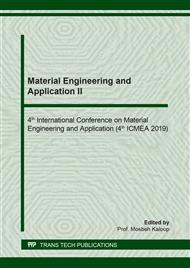p.138
p.144
p.150
p.155
p.161
p.166
p.171
p.177
p.182
Preliminary Investigation of Crushed Rock-Based Geopolymer for Road Applications
Abstract:
At present, our world is facing environmental issues, which is an increasing amount of carbon dioxide (CO2) generated by the Portland cement (OPC) production. To reduce that carbon dioxide emissions, some researchers have studied the alternative cementitious materials to replace the consumption of OPC, and geopolymer is one of the choices. Geopolymer cement (GP), a green technique for construction material, was applied for the road constructions by using Crushed rock (CR-the typical pavement material) as a starting material of geopolymer synthesis. The results showed that the optimum mixture to achieve both properties and economic aspect was 5M of NaOH concentration, 1.0 SS/SH ratio, 0.5 L/B ratio cured at room temperature. With that mixture, it passed the target compressive strength of Cement-treated base (CTB) for pavement (2.1-5.5 MPa) as well as achieving the CO2 reduction of 45.23% when compared to ordinary Portland cement.
Info:
Periodical:
Pages:
161-165
Citation:
Online since:
May 2020
Keywords:
Price:
Сopyright:
© 2020 Trans Tech Publications Ltd. All Rights Reserved
Share:
Citation:


